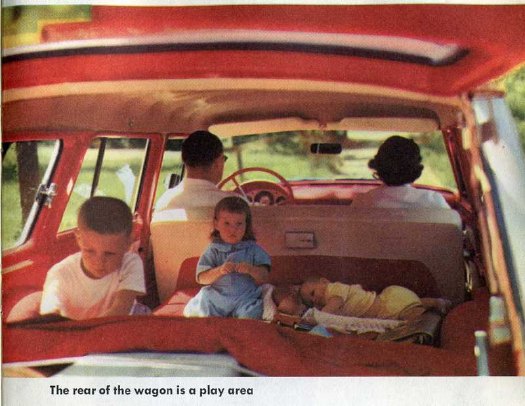 Dogs in loose in vehicles today remind me of vehicle safety for kids in the 1970's. My mom tells of my first car seat. It was a platform that hung over the front seat giving a mom a place to set the baby while driving. It was essentially a springboard that ensured a clear path to the windshield with sudden changes in force. Our family went on many drives to the Oregon coast with my brothers and I loose in the back of the family station wagon (you know the one - Faux wooden paneling on the sides) with our comic books, pillows, and blankets. Cars had seat belts but no one used them. Only the dorky parents made their kids wear them.
Dogs in loose in vehicles today remind me of vehicle safety for kids in the 1970's. My mom tells of my first car seat. It was a platform that hung over the front seat giving a mom a place to set the baby while driving. It was essentially a springboard that ensured a clear path to the windshield with sudden changes in force. Our family went on many drives to the Oregon coast with my brothers and I loose in the back of the family station wagon (you know the one - Faux wooden paneling on the sides) with our comic books, pillows, and blankets. Cars had seat belts but no one used them. Only the dorky parents made their kids wear them.Things have changed though. No one would leave their child unbuckled anymore. Childhood is a progression though a series of the appropriate car seats. Yet, the dogs are wandering about the car. If they are up front, airbag deployment can be lethal. Loose anywhere and they can become a projectile in an accident and be thrown around the car and may injure others in the car. There are number of commercial harnesses available. While they are a good start and a good idea, little to no independent testing has been done on them. Alarmingly, the Center for Pet Safety reports a high failure in crash test simulations they have performed on common brands. Their website does have one brand they certified. Crates are commonly thought of as a safe option. They can collapse in an accident though and their structural stability has rarely been tested.
So, many questions remain about how to achieve safe car travel for pets but following some basic principles can be lifesaving.
- No pet should ever be in the front seat.
- Small dogs and cats may be kept in carriers. The carriers should be placed in the back seat on the floor behind the front seats. Do not belt these to back seat seat belt. The carriers may collapse under force.
- Do not use booster seats.
- The safest place for a dog is in the back seat in a Center for Pet Safety approved harness, properly attached to the seat belt system. Do not attach tethers.
- Without the harness system, larger dogs are safest further back in caged cargo area systems as shown. A carrier in the back is the next best option.
Timothy R Kraabel, DVM, DABVP (Canine/Feline Practice)
Outreach Chairman, American Board of VeterinaryPractitioners

No comments:
Post a Comment